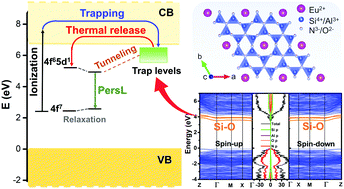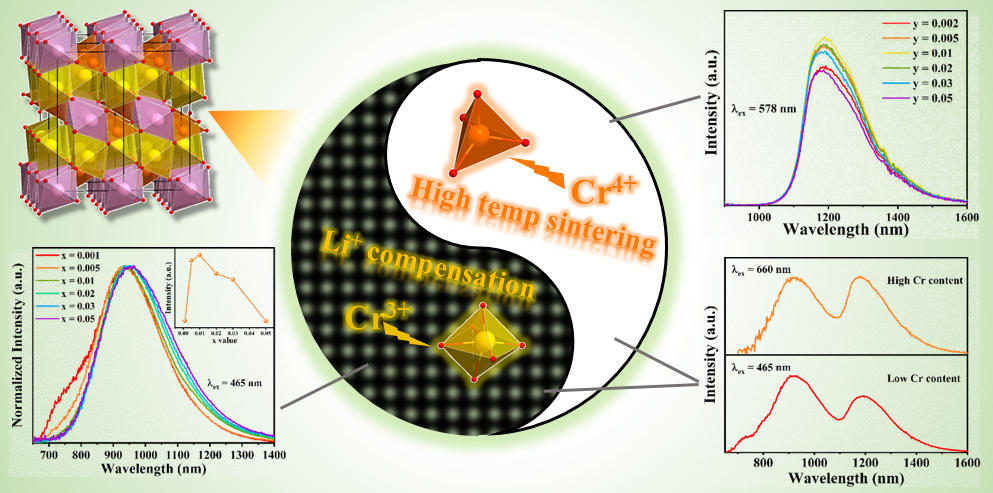Yb3þ-doped phosphors have characteristic near-infrared (NIR) emissions, but their applications in
phosphor-converted light-emitting-diodes (pc-LEDs) and Si solar cells are limited due to their mismatching
excitation spectra. Here, we selected nitride La3Si6N11 (LSN) as host material to achieve Yb3þ
NIR emission upon low-energy charge transfer (CT) excitation. The obtained phosphor LSN:Yb3þ has a
broad CT excitation band ranging from 250 to 500 nm and narrowband NIR emissions ranging from 950
to 1100 nm centered at 983 nm. On the basis of spectral data, the vacuum referred binding energies
(VRBE) schemes are constructed to locate energy levels of all lanthanide ions in LSN. We also fabricated
NIR pc-LED device using 395 nm LED chip to demonstrate the potential applications of LSN:Yb3þ
phosphors.
Green persistent luminescence and the electronic structure of β-Sialon: Eu 2+
https://pubs.rsc.org/en/content/articlelanding/2019/tc/c9tc03833g/unauth

Divalent europium doped aluminum silicate oxy-nitride (β-Sialon:Eu2+) has been widely used in backlights for liquid-crystal displays due to its outstanding green emission properties. Herein, the persistent luminescence (PersL) performance and electronic structure of β-Sialon:Eu2+ with the general formula Eu0.015Si5.5Al0.485O0.515N7.485 are first reported. The PersL duration is observed to be 400 s after 254 nm irradiation. By virtue of density functional theory (DFT) calculations, we verify that the trap levels responsible for PersL are impurity levels induced by Si–O bonds located below the bottom of the conduction band (CB) on random substitution of Al–O for Si–N in β-Si3N4. The trap depth and density are estimated through experimental data. The charging process for PersL is clarified by the thermoluminescence excitation (TLE) spectrum. The electronic structure diagrams (host referred binding energy, HRBE and vacuum referred binding energy scheme, VRBE) of β-Sialon:Eu2+ are constructed to deeply understand the PersL mechanism and luminescence behavior. We propose a novel strategy to construct the HRBE schemes, i.e. using the onset energy of the thermoluminescence excitation (TLE) spectrum as the energy difference between the 4f ground state and the bottom of the CB to pinpoint the 4f energy level location of Eu2+. This work would allow more rational design of luminescent materials.
Controlling Cr3+/Cr4+ concentration in single-phase host toward tailored super-broad near-infrared luminescence for multifunctional applications
Mater. Chem. Today,2021,22,100555.https://doi.org/10.1016/j.mtchem.2021.100555

Full control on the valence of the active ions in solids to improve properties is the central topic of chemistry and materials. Cr3+ and Cr4+ ions generally emit wavelength-different near-infrared (NIR) light. Here, we have developed a chromium valence-controllable single-phase phosphor, Mg2GeO4:Cr3+,Cr4+ to achieve super-broad NIR luminescence. High Li+ content charge compensators can stabilize Cr3+ while high temperature sintering tends to facilitate the formation of Cr4+. Through fine adjusting the synthesis conditions, pure Cr3+ or Cr4+ luminescence can be obtained with peak emission locating at 935 and 1190 nm, respectively. Super-broad-band dual emission spanning from 650 to 1600 nm is realized via fully controlling the concentration ratio of Cr3+ to Cr4+ in single host. By measuring the transmission spectra of several foodstuffs illuminated by our phosphors, nondestructive analysis in food safety area can be realized. This study provides a new strategy for exploiting super-broad-band NIR luminescent materials.
世界,您好!
欢迎使用WordPress。这是您的第一篇文章。编辑或删除它,然后开始写作吧!
Efficient Near‐infrared Pyroxene Phosphor LiInGe2O6:Cr3+ for NIR Spectroscopy Application
April 2021, Journal of the American Ceramic Society.https://doi.org/10.1111/jace.17856
 \
\
Broadband near-infrared phosphors are essential to realize nondestructive analysis in food industry and biomedical areas. Efficient long-wavelength (>830 nm) phosphors are strongly desired for practical applications. Herein, we demonstrate an efficient broadband NIR phosphor LiInGe2O6:Cr3+, which exhibits a broad NIR emission peaking at ~880 nm with a full width at half maximum of 172 nm upon 460 nm excitation. The internal/external quantum efficiencies of LiInGe2O6:Cr3+ are measured to be 81.2% and 39.8%, respectively. The absorption of the phosphor matches well with commercial blue LEDs. Using the fabricated phosphor converted LED illuminating human palm, distribution of blood vessels can be clearly recognized under a NIR camera. These results indicate that LiInGe2O6:Cr3+ is a promising candidate to be used in future non-destructive biological applications.
Color-Tunable Persistent Luminescence of Ca10M(PO4)7:Eu2+(M = Li, Na, and K) with a β-Ca3(PO4)2 -Type
Inorg. Chem. 2021, 60, 6, 3952–3960.https://doi.org/10.1021/acs.

Eu2+-activated Ca10M(PO4)7 (M = Li, Na, and K) phosphates have been explored extensively because of their tunable emission wavelengths and excellent luminescence performances. Herein, the persistent luminescence (PersL) properties of Eu2+-doped Ca10M(PO4)7 phosphors with a β-Ca3(PO4)2-type structure are reported. With the variation of alkali metal M from Li to Na and to K, the PersL color can be adjusted sequentially from yellow to white and to blue, and the persistent durations are prolonged significantly from about ∼61 s for Ca9.997Li(PO4)7:0.003Eu2+ to ∼1950 s for Ca9.999Na(PO4)7:0.001Eu2+ and to ∼7440 s for Ca9.9995K(PO4)7:0.0005Eu2+ at the threshold value (0.32 mcd/m2) after 254 nm irradiation. The trap depths are estimated according to the thermoluminescence glow curves with various heating rates. Comparing the thermoluminescence excitation and photoluminescence excitation spectra, it can be verified that there are two sources of ionized electrons in the charging process: one is excited from the valence band to the conduction band (CB) and the other is excited from the 4f ground state of Eu2+ to the higher 5d levels or directly to the CB. Finally, the PersL mechanism is proposed. This work is expected to motivate more research of Eu2+-doped phosphate-based PersL materials, as well as contributes to the understanding of the PersL mechanism of Eu2+-doped phosphors.
A Broadband Near-Infrared Phosphor Ca3Y2Ge3O12:Cr3+ with Garnet Structure
Journal of Alloys and Compounds, Volume 863, 15 May 2021, 158699.https://doi.org/10.1016/j.jallcom.

Near-infrared phosphor (NIR) integrated light-emitting diode (LED) has ideal application prospects in the fields of food inspection and medical imaging. Herein, we have synthesized a garnet-type Ca3Y2Ge3O12:Cr3+ NIR phosphor using solid state reaction method. Broadband NIR emission ranging from 700 to 1100 nm with a peak located at 800 nm indicates a weak crystal field strength for Cr3+, which occupies the six-coordinated Y3+ site. Moreover, the phosphor has satisfactory luminous intensity showing 81%/10% internal/external quantum efficiency and excellent luminescence thermal stability. Our work provides an excellent NIR phosphor choice for NIR LED devices.
Site engineering strategy toward enhanced luminescence thermostability of a Cr3+-doped broadband NIR phosphor and its application

Structural Confinement for Cr3+ Activators toward Efficient Near- Infrared Phosphors with Suppressed Concentration Quenching

Trivalent chromium ion-doped near-infrared (NIR) phosphors have been widely studied due to their tunable emission wavelengths and broad applications. High Cr3+ concentration can improve absorption efficiency but generally results in low emission intensity due to the concentration quenching effect. Herein, we report a series of efficient NIR phosphors with suppressed concentration quenching, Sr9M1–x(PO4)7:xCr3+ (M = Ga, Sc, In, and Lu), showing a broadband NIR emission ranging from 700 to 1100 nm peaking at 850 nm upon the 485 nm light excitation. The emission peak position is almost independent of the type of M ion and the Cr3+ dopant content, and the type of M ion has little influence on the luminescence thermal quenching, indicating that [MO6] octahedra are rigid enough to keep octahedral volumes and average M3+–O2– distances nearly constant owing to the formation of the framework structure on Cr3+ substitution. The NIR emission intensities monotonously increase with the Cr3+ content increasing from 0 to 80% with suppressed concentration quenching, the intensity of Sr9Cr(PO4)7 still maintains 84.23% of Sr9Ga0.2(PO4)7:0.8Cr3+ phosphor, and the thermal quenching behavior is slightly dependent on x; these effects can be attributed to the suppressed energy transfer due to the structural confinement effect. The optimal sample, Sr9Ga0.2(PO4)7:0.8Cr3+, has an internal/external quantum efficiency of 66.3%/29.9%. Finally, we fabricate a NIR phosphor-conversion light-emitting diode and demonstrate its applications in nondestructive examination and medical fields.
Tuning luminescence from NIR-I to NIR-II in Cr3+-doped olivine phosphors for nondestructive analysis
Journal of Materials Chemistry C .Issue 16, 2021
The practical application of near-infrared (NIR) phosphors is hindered due to their limited light emitting region and narrow bandwidth. Here, we report a series of Cr3+-doped olivine phosphors, (Mg1−xLix)(Mg1−xScx)GeO4:Cr3+, with tunable luminescence from NIR-I to NIR II based on crystallographic site engineering. By using a [Li+–Sc3+] unit substituting for a [Mg2+–Mg2+] unit, the NIR luminescence can be largely tuned from 940 nm to 1110 nm, and the corresponding FWHM can be modified from 236 to ∼300 nm. The internal quantum efficiency (IQE) and external quantum efficiency (EQE) of Mg2GeO4:1% Cr3+ were measured to be 48.19% and 16.38%, respectively. The photoluminescence of the phosphors matches well with the absorption of several functional groups. By measuring the NIR absorption of different liquids illuminated by NIR light from our phosphors, qualitative and quantitative analysis can be realized. These results suggest that the super-broad NIR luminescence of (Mg1−xLix)(Mg1−xScx)GeO4:Cr3+ has potential applications as light sources for nondestructive food analysis.


